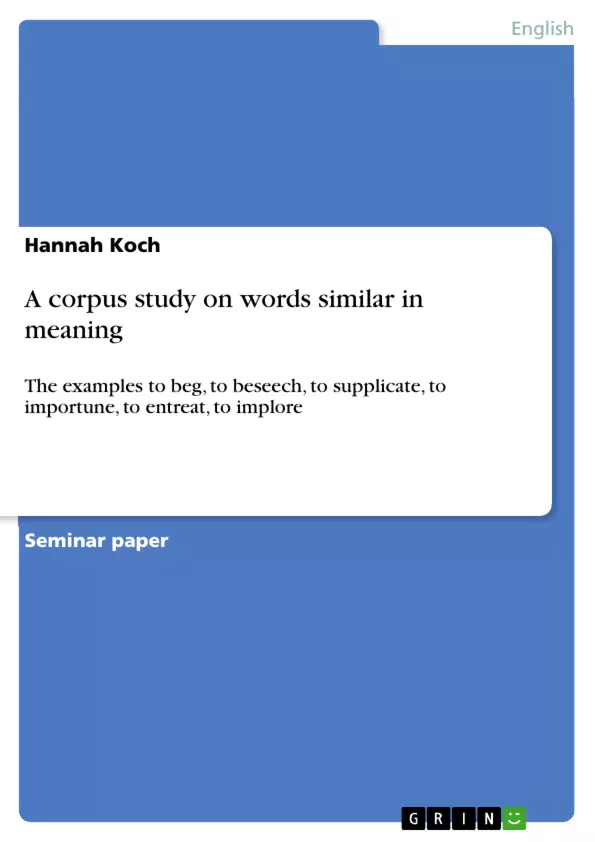This Firthian principle will guide the following corpus-based study which investigates how the words to beg, to beseech, to supplicate, to importune, to entreat, and to implore, which are similar in meaning, differ in semantic patterns.
Analysing and comparing the words in terms of their linguistic environment will reveal how the specific word is used naturally. Its idiomatic use might be surprising as language is always changing and developing, so one might find out new and unexpected aspects of a words use.
Chapter 2 explains the Lexical Priming approach by Michael Hoey and its significance regarding this study. Furthermore, the four categories collocation, colligation, semantic preference and semantic prosody will be defined in order to lay the groundwork for the analysis in chapter 4. In the following 3rd chapter, corpora will be defined as well as the Neo-Firthian tradition of using corpora for lexical analysis and information about the source corpus for this study, Sketch Engine for Language Learning, will be provided. The chapter then concludes explaining the limitations of this study. Chapter 4 will state a few conditions and limitations of the analysis and will then continue to present the qualitative analysis of the target words modelled after Sinclair’s model of extended lexical meaning. The 5th chapter will compare the results of chapter 4 to give an efficient overview of the semantic similarities and differences of the words. Lastly, chapter 6 will provide a concluding statement of whether they differ from each other at all or if they can substitute each other seamlessly. A final outlook will give additional ideas on how to expand this study.
Inhaltsverzeichnis (Table of Contents)
- INTRODUCTION
- HOEY'S LEXICAL PRIMING APPROACH
- Collocation
- Colligation
- Semantic Preference
- Semantic Prosody
- CORPUS LINGUISTICS
- Neo-Firthian Approach to Corpus Linguistics
- Sketch Engine for Language Learning
- Limitations of the Study
- CORPUS ANALYSIS
- Analysis of to beg
- Analysis of to beseech
- Analysis of to supplicate
- Analysis of to importune
- Analysis of to entreat
- Analysis of to implore
- COMPARISON
- CONCLUSION
Zielsetzung und Themenschwerpunkte (Objectives and Key Themes)
This corpus-based study investigates the semantic patterns of six English words similar in meaning: to beg, to beseech, to supplicate, to importune, to entreat, and to implore. By analyzing and comparing the words' linguistic environments, the study aims to reveal how each word is used naturally and to explore potential surprising aspects of their idiomatic use. The study employs Michael Hoey's Lexical Priming approach, a method that utilizes corpus linguistics to analyze the associations and patterns in language.
- The influence of linguistic environment on word meaning
- The role of collocation, colligation, semantic preference, and semantic prosody in shaping word use
- The application of corpus linguistics in analyzing lexical meaning
- The comparison of semantic patterns across similar words
- The implications of lexical priming for understanding language use
Zusammenfassung der Kapitel (Chapter Summaries)
- Introduction: This chapter introduces the study's focus on the semantic patterns of six similar words, highlighting the importance of understanding their idiomatic use in context. It also outlines the structure of the study, including the theoretical framework, methodology, and analysis.
- Hoey's Lexical Priming Approach: This chapter defines Michael Hoey's theory of lexical priming and explains its significance for the study. It then defines the categories of collocation, colligation, semantic preference, and semantic prosody, which are crucial for the analysis of the target words.
- Corpus Linguistics: This chapter discusses the role of corpora in lexical analysis, particularly within the Neo-Firthian tradition. It introduces the Sketch Engine for Language Learning as the source corpus for this study and outlines the study's limitations.
Schlüsselwörter (Keywords)
The study focuses on the keywords to beg, to beseech, to supplicate, to importune, to entreat, and to implore, analyzing their semantic patterns within a corpus of English language data. Key themes include lexical priming, collocation, colligation, semantic preference, and semantic prosody. The study employs corpus linguistics techniques and the Neo-Firthian approach to understand the idiomatic use of these words and the influence of their linguistic environment on their meaning.
- Arbeit zitieren
- Hannah Koch (Autor:in), 2017, A corpus study on words similar in meaning, München, GRIN Verlag, https://www.grin.com/document/1027154



